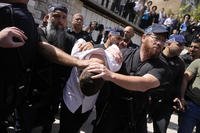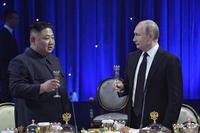Editor's note: As the debate over America's future course in Afghanistan roils the policy waters of Washington, noted military historian and professor at the Marine Corps University, Mark Moyar, argues in the following commentary that neither the population nor the enemy are the true center of gravity in a counter-insurgency. Leadership is the "critical variable" in these complex conflicts, Moyar argues.
On April 2, 2009, the House Armed Services Committee staged a hearing on Afghanistan that illustrated, with remarkable clarity, what this country has learned about counterinsurgency in the past eight years. The committee’s members called for a doubling of the Afghan security forces, which they said was required to protect the population, and they pressed for information on the equipment and salaries and trainers for those forces. Repeatedly they recommended adding civil affairs personnel as well as military forces, on the grounds that the military could not defeat the insurgents by itself. A senior Defense Department official asserted that President Obama wanted the deployment of more civilian and military resources to Afghanistan, improved civil-military synchronization, and better measures of effectiveness.
Only one person in the room understood the most serious challenges in Afghanistan. Fortunately for Americans, he was the commander of U.S. Central Command, Gen. David Petraeus. Beaming a ray of insight into the murk of the hearing, Petraeus asserted that “the biggest challenge that we have is not actually infrastructure, it’s not equipment, it’s not really even trainers over time.” The biggest challenge, he said, was Afghan leadership. “What you can't produce overnight or with a six-month or even a few-year course are those individuals who will command at the company, the battalion and the brigade level and serve on their staffs, and that just flat takes time and is the long pole in this particular tent.” These comments did not, however, have a discernible effect on the others in the room, as the musings and questions of the Congressmen continued as before.
General Petraeus’ remarks support an interpretation of counterinsurgency that has been considerably more popular among counterinsurgency’s practitioners than its theorists, an interpretation that must gain greater currency in the U.S. government if we are to prevail in Afghanistan. In the theoretical realm, the prevailing schools of thought are based around the “enemy-centric” and the “population-centric” views. According to the “enemy-centric” view, the key to victory is destroying the insurgency’s will and capabilities with coercion and armed force. The “population-centric” view, also known as the “hearts and minds” view, holds that the key is obtaining the population’s support by redressing its grievances.
Both of these schools make valuable and indisputable points. Destroying insurgents and obtaining popular support are both crucial in counterinsurgency. Yet neither activity is the critical variable in counterinsurgency; they are, rather, subordinate to the critical variable, which is leadership. Success in counterinsurgency depends primarily on the relative strengths of the counterinsurgent and insurgent leaders, not on the choice of methods from either the enemy-centric or population-centric playbooks. In a war of insurgency, the superior elite most often gains the support of more members of the population and uses that assistance to defeat the opposing elite and its supporters.
The past is littered with the carcasses of security force expansion programs that failed because they did not appreciate the centrality of leadership. Among those failures we can count the early development of the Afghan National Police and the Auxiliary Police program of 2007-2008. In case after case, planners assumed that creating security forces required merely recruiting, training, and equipping young men. While the organizers were able to complete those three tasks in a matter of months, they learned the hard way that competent leaders take much longer to produce.
Poorly led troops broke under fire. They often deserted or switched to the insurgent side, bringing their assault rifles with them. They used their authority and power to extract bribes from the population and commit acts of rape and pillage. Although people of different cultures view politics in very different ways, they share a strong aversion to behavior of this sort, and will take up arms in response. Indeed, they are much more likely to fight in reaction to the misdeeds of governmental personnel than for reasons of economic privation or political ideology. In Afghanistan, the misbehavior of policemen and civil servants has drastically increased the populace’s receptivity to the insurgents.
In Afghanistan today, the United States first must do its utmost to fix the severe leadership problems in the existing security forces. Too many lives are being squandered because Afghan officers lack experience or talent. The United States and its coalition partners need to pressure the senior Afghan leadership to curb cronyism and nepotism in the selection of leaders. Even if major progress is achieved in that area, however, there simply are not enough Afghan officers in existence with the necessary experience to lead the forces that have been created, not to mention the new forces already scheduled for formation.
Filling the leadership gap requires foreign, primarily American, officers and non-commissioned officers. They can compensate for Afghan deficiencies by serving as advisers or commanders of partner units. They can perform leadership tasks either directly or by providing tutelage to Afghan officers. General McChrystal has concluded that we need 30,000 to 40,000 more American troops to bolster the Afghan security forces through advising and partnering, and no one has provided a compelling case that those numbers are far from the mark. Enlarging the Afghan security forces without sending more Americans—a course of action with many advocates in Congress right now—will only enlarge failure.
Mark Moyar is a professor at the Marine Corps University and is the author of three books on counterinsurgency, most recently “A Question of Command: Counterinsurgency from the Civil War to Iraq.”








